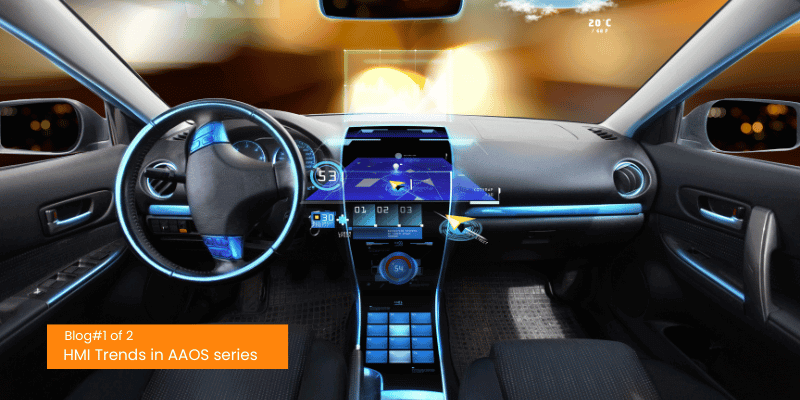- Vivek K
- August 19, 2024
HMI Trends In Android Automotive OS | Part 1
In the domain of Android Automotive OS (AAOS), Human-Machine Interface (HMI) trends are rapidly evolving to enhance user experiences within automotive environments. With a focus on improving safety, convenience, accessibility, and zero-defect production, AAOS is witnessing a surge in innovations aimed at revolutionizing how drivers interact with in-vehicle systems and car controls from applications. From touchless interfaces to voice commands, Augmented Reality to Heads-Up Displays, the integration of advanced HMI technologies has undergone significant transformation and is reshaping the driving experience. In this blog, we dive into the intersection of AAOS and HMI trends, exploring the implications for the automotive industry and the future of driving.
Understanding Human-Machine Interface (HMI):
A Human-Machine Interface is a user interface or dashboard or software application that enables a driver or even a passenger to interact with a machine, system, or device. It can be applied to any screen that allows a user to interact with device like, car displays, monitor/tablet displays, input/output displays etc. It has evolved from basic physical controls like knobs and switches to sophisticated touchscreens interfaces, voice assistant and gesture recognition systems, providing user diligent and smooth interaction with vehicle functions. For example, the Polestar 2 features a sleek infotainment system powered by AAOS, with a large central touchscreen that serves as the primary interface for navigation, entertainment, and vehicle settings.
Understanding Android Automotive OS (AAOS):
With the increase in smartphone usage and increase demand for connected services, automotive manufacturers are turning to Android-based OS to power their advanced infotainment. Android Automotive OS is one such operating system which provides an infotainment platform built into cars, a driver can download compatible apps directly. These systems leverage the power of Android’s open-source platform to provide a versatile environment for developing feature-rich infotainment systems, navigation systems, driver assistance tools, and more.
Prominent automakers, like General Motors, Volvo, and Polestar, have adopted AAOS as the cornerstone of their next-generation infotainment systems, realising its potential to provide a smooth and user-friendly interface. The goal of these manufacturers is to improve connectivity, productivity, and entertainment options for both drivers and passengers.
Key Features of AAOS:
Open-Source Framework: AAOS is built on the Android open-source platform, enabling developers to leverage familiar tools, APIs, and development frameworks for building automotive applications. This fosters innovation and collaboration within the automotive ecosystem.
Scalable Architecture: AAOS is designed to support a variety of hardware configurations, from entry-level head units to advanced multimedia systems with high-resolution displays, touchscreens, and voice recognition capabilities. This scalability ensures compatibility across different vehicle models and manufacturers.
Connectivity and Integration: AAOS provides strong connectivity features, including support for Bluetooth, Wi-Fi, NFC, and cellular networks. This makes it possible for integration with smartphones, smartwatches, IoT devices, and cloud services, allowing drivers to access and control over their digital ecosystem from the vehicle’s dashboard.
Multimedia Capabilities: AAOS offers powerful multimedia capabilities, such as multimedia playback, streaming services, and audio/video playback controls. This enhances the in-car entertainment experience for passengers and provides access to a wide range of content sources.
Navigation and Mapping: Powered by top mapping suppliers, AAOS comes with integrated navigation and mapping features. This enhances the driver’s situational awareness and route planning abilities by providing real-time navigation, turn-by-turn directions, traffic updates, and point of interest (POI) search.
Voice Recognition and Natural Language Processing (NLP): AAOS integrates cutting-edge speech recognition and NLP technologies, allowing drivers to communicate with the vehicle using natural language instructions. This hands-free interface enables safer and more cautious control of infotainment features, phone calls, messaging, and other functions while driving.
Key Concepts and Components:
To build an HMI by a third-party developer, OEMs, and end users, a list of components and concepts required are provided by Android Automotive System UI and core apps.
Android Open-Source Project (AOSP) Host: The AOSP Automotive App host is a component of Car App Library and a system application used by third-party developers to facilitate apps for Android Automotive.
- To run third-party apps, both the app and App Host must be installed.
- App host provides third-party apps with a set of templates and optimized components for vehicles.
- OEMs can style this UI template and component based on their need.
- The third-party app is now can be integrated into the infotainment system of OEM.
Car Setting Structure: Structure provided by AAOS, which contains car-centric visual user interface, driver distraction optimization, and numerous customization entry points for OEMs. This can include adding proprietary features, integrating third-party services, or offering unique options tailored to their vehicles.
Car UI Library: Statically linked library, which provides a set of components that can be used to implement System and OEM apps, and AAOS apps. It provides a UI development framework that ensures the application present in dashboards can attains Self-consistency (a user can predict how to interact with dashboards based on previous interactions with system) and Customization (OEM can modify the system’s UI to best integrate functionality with vehicle hardware).
Customizable Status Bar: Component of Android System UI, used to constantly show crucial information to users. It can include time, temperature or OEM’s unique options tailored to their needs.
Notifications: Messaging mechanism to provide updates, reminders, or any other crucial information. In AAOS, a notification can be displayed like any phone display as a heads-up notification or in the Notifications panel.
Dialer: System application to support Distraction-optimized Bluetooth calling, call management and Contact browsing. A OEMs can build a fully-complaint Android User Experience Restriction (UXR) telecom system with Android Automotive. UXR is an application that displays a user interface dependent upon driving state.
Media: Platform to build media apps that provides connected infotainment experience in cars, which is designed to provide a Distraction Optimized playback and browsing experience.
Key Factors influencing automotive HMI:
Several factors are encouraging OEMs to research and work with automotive HMI design more so than ever. Some notable factors include:
Next-generation Cockpit/Displays: Today’s digital dashboard provides highly intelligent and multifunctional displays resulting in effective in-car experience. The trends to keep an eye on include Heads-up Display, Augmented and Virtual reality, 3D/4D visualization and lightning and audio correspondence to of a movie theatre. Game Engines like Unity or Unreal Engine can be used for rich UI along with gamification tools to create interactive interface.
Connected Car Applications (CCA): CCA gives users access to a variety of services through user-friendly interfaces that can be accessed via infotainment system in cars or smartphone integration. Some features and trends include:
- Real-time navigation, traffic updates, vehicle information/diagnostics.
- Remote vehicle control like locking/unlock, start, vehicle locator, car’s climate control, and speed alerts etc.
- Multimedia control.
- Automakers can utilize apps to communicate to consumers about their new features, news brand identity and to make purchasing process experience paperless by offering virtual test drive, and online dealership information.
These user-friendly applications aim to streamline access to information and services minimizing hindering driver’s attention.
In-car Assistant: An assistant integrated into the vehicle’s infotainment system that enables drivers to interact with various features and services using voice commands or other input methods. Also, Integration of Natural Language Processing (NLP) and Machine Learning (ML) technologies enhances its capabilities. Some functionalities include:
- Voice-Activated Controls and Searches
- Navigation, Emergency and Safety Assistance
- Media playback control
- Hands free calling
- Personalized Recommendation
Multi-Modal Interface: A multi-modal interface refers to a user interface that provides a driver or passenger multiple modes to interact with infotainment systems. Instead of traditional input methods like buttons or touchscreens, this interface provides various ways including Gestures (Hand, Face, Head etc.), Voice commands, touch inputs and physical control as well.

Cyber Security and Data Protection: The term “cybersecurity” in HMI trends refers to strategies and tools used to defend connected cars’ digital interfaces from online threats and intrusions. Some key aspects of cybersecurity in HMI include:
- Secure Communications Protocol – HTTPS, MQTT etc.
- Authentication and Access Control – Apart from security, it can also help in identifying the driver or passenger so that the system can provide information accordingly.
- Security by Design and at development level.
- Security Awareness and Training
Conclusion:
With its features like open source and smooth integration, AAOS is revolutionizing the way drivers and passengers interact with vehicles. With the latest technologies in HMI design and implementation, an OEM can provide a fascinating, user-friendly, and personalized experience that has advanced safety, optimization, convenience, and enjoyment with optimized distraction. Moving ahead in automotive technology, HMI solution and AAOS will continue to reshape the driving experience.
However, there are also limitations to HMI implementation like high computer requirements to handle heavy graphics. In the second part of this blog we will discuss the alonguse of Game engines with a sample project based on AAOS and HMI.


































